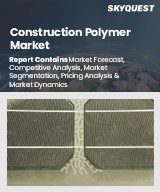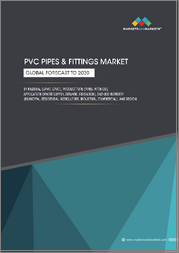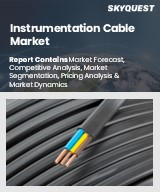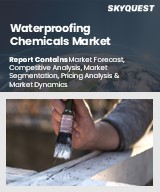
|
시장보고서
상품코드
1521086
세계의 바이오 기반 폴리염화비닐 시장 : 예측(2024-2029년)Bio-based Polyvinyl Chloride Market - Forecasts from 2024 to 2029 |
||||||
세계 바이오 기반 폴리염화비닐 시장 규모는 2024년부터 2029년까지 연평균 4.8%의 CAGR을 기록할 것으로 예상됩니다.
바이오 기반 폴리염화비닐은 재생 가능한 생물 자원에서 추출한 바이오 기반 플라스틱의 일종입니다. 폴리염화비닐(PVC)은 세계에서 가장 일반적인 폴리머 중 하나이며 수많은 산업 분야에서 사용되고 있습니다. 건축 및 건설에서 PVC 배관 시스템은 높은 링 강성, 우수한 내식성 및 내 화학성, 긴 서비스 수명을 제공하며 PVC 파이프의 비 플라스틱 대체품은 제품 설계, 운송 및 제조에 최적화되어 있습니다.
바이오 기반 폴리염화비닐의 용도는 스포츠 및 신발에서 자동차, 포장, 농업, 부직포, 섬유 분야로 확대되고 있습니다. 플라스틱 사용 수요는 2019년 4억 5,974만 5,900톤에서 2060년 12억 3,062만 7,000톤으로 약 3배 증가할 것으로 예상됩니다. 전 세계 플라스틱 폐기물은 2019년 3조 5,329억 1,100만 톤에서 2060년 10조 1,414억 4,400만 톤으로 증가할 것으로 예상됩니다. 이러한 낭비는 환경 위기의 큰 문제를 야기하고 있습니다. 이러한 플라스틱의 무질서한 소비는 폐기물 관리 시스템의 과제로 이어지고 있습니다.
전체적으로 재료의 이산화탄소 배출량은 조달을 통해 줄일 수 있으며, PVC 제품은 재생 가능한 식물 유래 유도체에서 조달되며, PVC 제조에 사용되는 비식량 유래 바이오매스 공급원으로는 사탕수수, 목재 펄프, 사용 된 식용유 등이 있습니다.
OECD에 따르면 플라스틱 폐기물의 9%만 재활용되고 있습니다. 그러나 15 %는 재활용을 위해 회수되지만 약 6%는 잔류 물로 폐기됩니다. 약 50%는 매립되어 토양 오염과 토양 품질 저하를 유발합니다.
바이오 기반 연질 PVC 컴파운드는 재생 가능한 원료로 만든 식물성 가소제를 사용하여 분해되지 않는 기존의 석유 기반 가소제가 아닌 토양에 쉽게 들어갈 수 있는 지속가능한 원료를 생산합니다.
바이오 기반 폴리염화비닐 시장의 촉진요인
- 유리한 규제 조치
세계 각국 정부는 일회용 플라스틱을 단계적으로 폐지하고 재활용 가능한 재료로 대체하고 있습니다. 뉴질랜드 정부는 음료수 교반기, 플라스틱 줄기 면봉, 플라스틱 과일 봉지, 플라스틱 접시, 그릇, 수저, 플라스틱 빨대를 퇴비화 가능한 플라스틱 및 바이오 기반 플라스틱으로 단계적으로 전환하는 것을 추진하고 있습니다. 유럽의회는 EU의 포장 및 용기 포장 폐기물 규정(PPWR)을 채택하여 플라스틱 및 기타 포장재 감축을 의무화했습니다. 이 규정은 가공되지 않은 신선한 과일과 채소, 카페와 레스토랑에서 소비되는 음식과 음료의 일회용 플라스틱 포장을 금지하는 것을 의무화했습니다. 이 규정은 2030년 1월 1일부터 시행됩니다.
정부와 산업계는 넷제로와 순환경제에 대한 노력을 추진하고 있습니다. 이는 에너지 안보, 일자리 창출, 사회 경제 발전의 주요 발전입니다. 현재 전 세계 인구의 거의 절반이 도시에 거주하고 있으며, 2070년에는 70%에 달할 것으로 예상됩니다. 이 많은 인구를 유지하려면 인프라와 작업 공간이 필요합니다. 바이오 기반 재료는 사탕수수 등에서 얻은 바이오 기반 폴리염화비닐을 포함한 생물 유래 재료입니다.
바이오 기반 건축은 점점 더 많은 기업들이 일찍이 채택하고 있습니다. 스웨덴 수도 남부의 시크라에 위치한 스톡홀름 우드 시티(Stockholm Wood City)는 25만 평방미터 부지에 2,000채의 주택과 7,000개의 사무실, 레스토랑, 상점을 건설하는 프로젝트로 2025년에 착공할 예정입니다. 이 도시는 녹색 지붕 등 자연 요소를 디자인에 반영하고 있습니다.
- 높아지는 건설 및 건축 산업 수요
건축 및 건설 산업의 성장은 건설 자재에 대한 관련 수요를 창출하고 있습니다. 미국의 총 건설 지출은 2022년 1월 1조 7,964억 6,000만 달러에서 2023년 1월에는 1조 8,821억 9,900만 달러로 급증했습니다. 이러한 건설 산업의 성장은 지속가능한 자재 조달이 필요한 전 세계적인 과제와 함께 합니다. 예를 들어, 카길은 바이오 유래 원료로 가소제를 생산하여 바닥재 성분으로 사용하고 있습니다. 이는 프탈레이트 및 화석 연료에 의존하는 제품에 대한 대안을 제공하기 위한 것입니다.
이네오스의 Inovyn과 같은 혁신적인 솔루션은 파리에 본사를 둔 바닥재 제조업체인 Tarkett의 새로운 바닥재 컬렉션에 채택되었습니다. 또한, Biovyn Inovyn(Ineos)은 파이프 및 창틀의 건축 및 건설과 같은 많은 산업에서 부가가치가 높은 용도를 가질 수 있습니다. 또한, 자동차 및 의료 분야에도 적용되고 있습니다. 바이오빈은 지속가능한 바이오소재에 관한 원탁회의(RSB)의 인증을 받은 바 있습니다.
예측 기간 동안 아시아태평양이 바이오 기반 폴리염화비닐 시장을 독점할 것으로 예상
중국, 일본, 인도, 한국 등 주요 경제국들이 아시아태평양을 지배하고 있습니다. 빠르게 성장하는 신흥국 중 일부는 아세안 국가 등 이 지역의 국가들입니다. 인도와 중국은 세계 인구의 약 35.5%를 차지하고 있습니다. 이와 관련하여, 인프라 구축에 중점을 둔 건설 및 부동산 산업의 급속한 성장은 보다 지속가능한 옵션을 포함한 다양한 재료에 대한 수요를 창출하고 있습니다.
중국은 전 세계 건설 및 개발 분야에서 선두를 달리고 있는 국가 중 하나이며, 2022-2023년 몇 차례의 불황을 겪은 후 정부의 규제와 정책을 개선하는 방향으로 나아가고 있습니다. 정부의 지원과 투자로 인해 친환경 건축 개념이 시장에서 확대되고 있습니다. 차이나 비즈니스 리뷰(China Business Review)에 따르면, 새로운 규제로 인해 도시 내 신축 건물의 약 70%가 녹색 건물 인증을 받아야 할 것으로 보입니다. 여기에는 학교, 병원, 공공시설도 포함됩니다. 이 건물들은 저탄소 건축, 재생에너지, 물 절약, 지속가능한 재료 등을 사용해야 합니다.
바이오 기반 폴리염화비닐 시장의 과제:
- 바이오 기반 폴리염화비닐을 기반으로 한 재료의 대규모 조달과 응용은 기존 플라스틱을 대체할 수 있는 도전이 되고 있습니다. 기존 플라스틱은 바이오 기반 폴리염화비닐에 비해 생산이 용이하고 응용 분야에 쉽게 채택할 수 있습니다. 지속적인 시장 적응과 비용은 폴리염화비닐의 과제입니다.
바이오 기반 폴리염화비닐 시장의 주요 발전:
- 2024년 3월, Baerlocher USA는 Innoleics와 새로운 파트너십 계약을 발표했습니다. 이 계약에 따라 Baerlocher USA는 바이오 기반 가소제인 연질 폴리염화비닐(PVC) 용도의 Innoleics 제품을 미국 시장에서 판매할 수 있게 됐습니다. 이 회사는 맞춤형 바이오 가소제/액체 혼합 금속 원팩 솔루션을 생산할 수 있습니다. 이 전략적 파트너십은 Baerlocher USA가 플라스틱 산업에서 저명한 공급업체로 자리매김하는 데 도움이 될 것으로 보입니다. 이 제품은 전선 및 케이블, 합성 피혁, 신발, 바닥재 등의 분야에 적용될 수 있으며, Innoleics의 저탄소발자국 소재와 Baerlocher의 기술 전문 지식은 어려운 지속가능성 목표를 달성하는 데 도움이 될 것으로 보입니다.
- 2023년 6월, Kommerling의 Bio-attributed PVC는 더 많은 지속가능성을 향한 프로젝트입니다. 이 프로젝트는 Stenwijk의 Royal BAM Group에 의해 시작되어 19 개의 사회 임대 아파트를 지속가능한 솔루션으로 현대화 할 것입니다. 화석 원료를 100% 재생 가능한 대체 재료로 대체하는 이 프로젝트는 에틸렌 생산에 석유 대신 소나무 기름을 기반으로 한 원료를 사용하여 CO2 배출량을 줄입니다. 이번 네덜란드 프로젝트에서는 약 6,000kg의 CO2를 감축한 지속가능한 건축자재를 생산했습니다.
- 2022년 12월, 와빈 올비아의 건축 및 인프라 사업부는 상수도 사업 및 인프라를 위한 바이오 기반 식수 솔루션 포트폴리오를 발표했습니다. 이는 지속가능한 제품의 새롭고 혁신적인 제품군입니다. 이 바이오 순환 원료는 탄소발자국을 75%까지 줄일 수 있으며, KIWA 인증 제품은 기존 제품 포트폴리오와 동일한 기술적 특성과 성능을 보장합니다. 또한, 국제 지속가능성 및 탄소 인증(ISCC)은 조달 관행, 윤리, 생물 다양성, 토지 이용, 동물 먹이 사슬에 대한 투명성을 인증했습니다.
- 2022년 8월, 콘티넨탈은 표피재 생산에 바이오 PVC BIOVYN을 채택했습니다. 이 회사는 자동차의 기술 및 장식용 표면 소재에 이노빈의 바이오 유래 PVC 인 BIOVYN을 사용할 예정이며, BIOVYN은 지속가능한 생물학적 재료에 관한 원탁 회의(RSB)의 인증을받은 PVC 등급으로 100 % 재생 가능한 원료입니다. 이 혁신적인 제품으로 온실가스의 70%를 줄일 수 있습니다. 더 많은 자동차 제조업체들이 이산화탄소 배출량을 줄이기 위해 지속가능한 원료를 찾고 있습니다.
목차
제1장 소개
- 시장 개요
- 시장 정의
- 조사 범위
- 시장 세분화
- 통화
- 가정
- 기준 연도와 예측 연도 타임라인
- 이해관계자에 대한 주요 이점
제2장 조사 방법
- 조사 디자인
- 조사 과정
제3장 주요 요약
- 주요 조사 결과
- 애널리스트의 견해
제4장 시장 역학
- 시장 성장 촉진요인
- 유리한 규제 조치
- 건설 업계의 수요 상승
- 시장 성장 억제요인
- 기존 재료에서 적응과 경쟁력 있는 비용
- Porter's Five Forces 분석
- 업계 밸류체인 분석
제5장 바이오 기반 폴리염화비닐 시장 : 용도별
- 소개
- 파이프
- 와이어와 케이블
- 봉투, 빈, 보틀
- 농업용 필름
- 전기·전자
- 기타 용도
제6장 바이오 기반 폴리염화비닐 시장 : 유형별
- 소개
- 경질
- 연질
제7장 바이오 기반 폴리염화비닐 시장 : 최종 이용 산업별
- 소개
- 건축·건설
- 자동차
- 헬스케어
- 농업
- 포장
- 기타 최종 이용 산업
제8장 바이오 기반 폴리염화비닐 시장 : 지역별
- 세계의 개요
- 북미
- 미국
- 캐나다
- 멕시코
- 남미
- 브라질
- 아르헨티나
- 기타 남미
- 유럽
- 영국
- 독일
- 프랑스
- 이탈리아
- 스페인
- 기타 유럽
- 중동 및 아프리카
- 사우디아라비아
- 아랍에미리트
- 기타 중동 및 아프리카
- 아시아태평양
- 중국
- 인도
- 일본
- 한국
- 대만
- 태국
- 인도네시아
- 기타 아시아태평양
제9장 경쟁 환경과 분석
- 주요 기업과 전략 분석
- 시장 점유율 분석
- 합병·인수·협정·협업
- 경쟁 대시보드
제10장 기업 개요
- Vynova Group
- Cargill
- Tarkett
- Teknor Apex
- Avient Corporation
- Orbia
- ENSO Plastics
- RENOLIT SE
- Westlake Vinnolit GmbH & Co. KG
- Inovyn
The bio-based polyvinyl chloride market is anticipated to register a compound annual growth rate (CAGR) of 4.8% between 2024 and 2029.
Bio-based polyvinyl chloride comes from renewable biological resources, it is a type of bio-based plastic. Polyvinyl chloride (PVC) is one of the most common polymers in the world, used in numerous industries. In building and construction, PVC piping systems offer high ring stiffness, excellent corrosion and chemical resistance, and a long service life. The non-plastic alternatives of PVC pipes are optimized for product design, transportation, and manufacturing.
The applications for bio-based polyvinyl chloride have been increasing from sports and footwear to automotive, packaging, agriculture, non-wovens, and fiber applications. The demand for plastics use is projected to reach 1230.627 million tonnes (Mt) by 2060 from 459.7459 million tonnes (Mt) in 2019, nearly a three times growth. Global plastic waste is expected to rise from 353.2911 Mt in 2019 to 1014.144 Mt in 2060. This wastage has been creating a huge problem for the environmental crisis. This uncontrolled consumption of plastic has led to a challenge for waste management systems.
Overall, the carbon footprint of the material can be brought down by sourcing. PVC products are sourced from renewable plant-based derivatives. Such as non-food-based biomass sources used in PVC production are sugar cane, wood pulp, or used cooking oil.
According to the OECD, only 9% of the plastic waste is recycled. But 15% was collected for recycling, but about 6% was disposed of as residues. About 50% end up in landfills, creating soil pollution and deterioration of soil quality.
Bio-based flexible PVC compounds use plant-based plasticizers made from renewable feedstock which creates a sustainable raw material that easily gets into the soil rather than traditional petroleum-based plasticizers, which remains unresolved.
BIO-BASED POLYVINYL CHLORIDE MARKET DRIVERS:
- Favorable regulatory measures
Governments around the world are phasing out single-use plastics and replacing them with recyclable materials. The New Zealand government has been promoting the phasing out of drink stirrers, plastic-stemmed cotton buds, plastic produce bags, plastic plates, bowls, and cutlery, and plastic straws with compostable and bio-based plastics. In April 2024, the European Parliament adopted the EU's Packaging and Packaging Waste Regulation (PPWR) which required reductions in plastics and other packaging. The rules required a ban on single-use plastic packaging for unprocessed fresh fruit and vegetables and foods and beverages consumed in cafes and restaurants. The rule is starting from 1 January 2030.
Governments and industry are taking steps for a net zero and circular economy. It is the key to energy security, job creation, and socio-economic development. Today almost half the global population lives in cities and by 2070 this is expected to reach 70%. Infrastructure and working space are needed the sustain such a large population. Bio-based materials are derived from living organisms, including bio-based polyvinyl chloride, which can be derived from sugarcane, etc.
Bio-based construction is growing among early adopters. One such project is Stockholm Wood City in Sickla, an area in the south of the Swedish capital. The construction would be on the 250,000-square-metre site and begin in 2025, along with 2,000 homes and 7,000 offices, restaurants, and shops. This city is incorporated with natural elements, such as green roofs, in its design.
- The growing demand from the construction and building industry
The growth of the building and construction industry has created a related demand for construction materials, the total construction spending in the United States was 1,796,460 million dollars in January 2022, which jumped to 1,882,199 million dollars in January 2023. This growth in the construction industry remains with the challenges in the world where the sourcing of sustainable materials is needed. Several products and innovations are serving to make construction materials and components more sustainable. for instance, Cargill offers plasticizers from bio-based feedstocks that are used as components for flooring. This is to provide an alternative to phthalate and fossil fuel-dependent products.
Innovating solutions like Inovyn by Ineos worked with flooring Paris-based firm Tarkett for its new flooring collection. Further, Biovyn Inovyn (Ineos) could have numerous value-added applications in many industries in building and construction for pipe, and window frames. They are moving towards automotive and medical applications too. Biovyn is also Roundtable on Sustainable Biomaterials (RSB) certified.
Asia Pacific region to dominate the bio-based polyvinyl chloride market during the forecast period.
The major economies like China, Japan, India, and South Korea dominate the Asia-Pacific region. Some of the fastest-growing emerging economies are from this region such as ASEAN countries. India and China have about 35.5% of the world's population. In this regard, the rapid growth of the construction and real estate industry with a growing focus on infrastructural development has created the demand for various materials including more sustainable choices.
China is one of the sought-after countries for construction and development around the world. After, a few downturns in 2022-2023, the country is moving towards better government regulations and policies. The concept of green building is growing in the market, with government backing and investments. According to the China Business Review, new regulations could require about 70% of new urban buildings to be certified green buildings. This also includes schools, hospitals, and public buildings. These buildings require low-carbon construction, renewable energy, water conservation, sustainable materials, etc.
Bio-based polyvinyl chloride market challenges:
- The large-scale sourcing and application of the bio-based polyvinyl chloride-based material has been a challenge in replacing traditional plastics. Traditional plastics are easy to manufacture and adopt in the application compared to bio-based polyvinyl chloride. The continuous market adaptation and cost are challenges for polyvinyl chloride.
Bio-based polyvinyl chloride market Key Developments:
- In March 2024, Baerlocher USA announced a new partnership agreement with Innoleics. The deal would lead to the distribution of Innoleics' by Baerlocher USA for the bio-based plasticizers flexible polyvinyl chloride (PVC) applications in the U.S. market. The company could produce customizable bio-plasticizer/liquid mixed metal one-pack solutions. This strategic partnership would help Baerlocher USA to establish itself as a prominent supplier for the plastics industry. The product could be applied in segments such as wire and cable, synthetic leather, footwear, and flooring. Low carbon footprint materials by Innoleics, with the baerlocher's technical expertise, will help in reaching challenging sustainability goals.
- In June 2023, Bio-attributed PVC by Kommerling is a project moving towards more sustainability. The project was launched by the Royal BAM Group in Steenwijk, in which 19 social rental apartments are being modernized into sustainable solutions. The project in which fossil materials are 100 percent replaced by a renewable alternative, is based on the pine oil-based raw material instead of petroleum in the production of ethylene, leading to the reduction of CO2 production. In the current project in the Netherlands, they produced sustainable building materials saving about 6,000 kilograms of CO2. The project was an assurance of innovative future products for sustainability.
- In December 2022, Wavin Orbia's Building and Infrastructure business launched a bio-based drinking water solutions portfolio for water utilities and infrastructure. This is a new innovative range of sustainable products. This bio-circular feedstock could reduce the carbon footprint by 75%. KIWA-certified product guarantees the same technical properties and performance as its existing product portfolios. Additionally, International Sustainability and Carbon Certification (ISCC) certified transparency on sourcing practices, ethics, biodiversity, land use, and animal food chain. They are reusing raw material streams, and reducing dependence on fossil-based raw materials.
- In August 2022, Continental selected bio-attributed PVC BIOVYN for the production of surface materials. The company would use BIOVYN, bio-attributed PVC, from INOVYN for the technical and decorative surface materials for automobiles. BIOVYN is a PVC grade that is certified by the Roundtable on Sustainable Biomaterials (RSB). It is a 100% renewable raw material. 70% of greenhouse gas savings would be saved from this innovative product. As more automotive manufacturers are demanding sustainable raw materials for reducing carbon footprint.
The bio-based polyvinyl chloride market is segmented and analyzed as follows:
By Application
- Pipes
- Wires And Cables
- Bags, Bins, And Bottles
- Agricultural Films
- Electrical And Electronics
- Other Applications
By Type
- Rigid
- Flexible
By End-user Industry
- Building and Construction
- Automotive
- Healthcare
- Agriculture
- Packaging
- Other End-user Industries
By Geography
- North America
- United States
- Canada
- Mexico
- South America
- Brazil
- Argentina
- Rest of South America
- Europe
- United Kingdom
- Germany
- France
- Italy
- Spain
- Rest of Europe
- Middle East and Africa
- Saudi Arabia
- United Arab Emirates
- Rest of Middle East and Africa
- Asia-Pacific
- China
- India
- Japan
- South Korea
- Taiwan
- Thailand
- Indonesia
- Rest of Asia-Pacific
TABLE OF CONTENTS
1. INTRODUCTION
- 1.1. Market Overview
- 1.2. Market Definition
- 1.3. Scope of the Study
- 1.4. Market Segmentation
- 1.5. Currency
- 1.6. Assumptions
- 1.7. Base and Forecast Years Timeline
- 1.8. Key benefits for the stakeholders
2. RESEARCH METHODOLOGY
- 2.1. Research Design
- 2.2. Research Process
3. EXECUTIVE SUMMARY
- 3.1. Key Findings
- 3.2. Analyst View
4. MARKET DYNAMICS
- 4.1. Market Drivers
- 4.1.1. Favorable regulatory measures
- 4.1.2. The growing demand from the construction and building industry
- 4.2. Market Restraints
- 4.2.1. Adaptation and competitive cost from traditional materials
- 4.3. Porter's Five Forces Analysis
- 4.3.1. Bargaining Power of Suppliers
- 4.3.2. Bargaining Power of Buyers
- 4.3.3. The Threat of New Entrants
- 4.3.4. Threat of Substitutes
- 4.3.5. Competitive Rivalry in the Industry
- 4.4. Industry Value Chain Analysis
5. BIO-BASED POLYVINYL CHLORIDE MARKET BY APPLICATION
- 5.1. Introduction
- 5.2. Pipes
- 5.3. Wires And Cables
- 5.4. Bags, Bins, And Bottles
- 5.5. Agricultural Films
- 5.6. Electrical And Electronics
- 5.7. Other Applications
6. BIO-BASED POLYVINYL CHLORIDE MARKET BY TYPE
- 6.1. Introduction
- 6.2. Rigid
- 6.3. Flexible
7. BIO-BASED POLYVINYL CHLORIDE MARKET BY END-USER INDUSTRY
- 7.1. Introduction
- 7.2. Building and Construction
- 7.3. Automotive
- 7.4. Healthcare
- 7.5. Agriculture
- 7.6. Packaging
- 7.7. Other End-user Industries
8. BIO-BASED POLYVINYL CHLORIDE MARKET BY GEOGRAPHY
- 8.1. Global Overview
- 8.2. North America
- 8.2.1. United States
- 8.2.2. Canada
- 8.2.3. Mexico
- 8.3. South America
- 8.3.1. Brazil
- 8.3.2. Argentina
- 8.3.3. Rest of South America
- 8.4. Europe
- 8.4.1. United Kingdom
- 8.4.2. Germany
- 8.4.3. France
- 8.4.4. Italy
- 8.4.5. Spain
- 8.4.6. Rest of Europe
- 8.5. Middle East and Africa
- 8.5.1. Saudi Arabia
- 8.5.2. United Arab Emirates
- 8.5.3. Rest of Middle East and Africa
- 8.6. Asia-Pacific
- 8.6.1. China
- 8.6.2. India
- 8.6.3. Japan
- 8.6.4. South Korea
- 8.6.5. Taiwan
- 8.6.6. Thailand
- 8.6.7. Indonesia
- 8.6.8. Rest of Asia-Pacific
9. COMPETITIVE ENVIRONMENT AND ANALYSIS
- 9.1. Major Players and Strategy Analysis
- 9.2. Market Share Analysis
- 9.3. Mergers, Acquisitions, Agreements, and Collaborations
- 9.4. Competitive Dashboard
10. COMPANY PROFILES
- 10.1. Vynova Group
- 10.2. Cargill
- 10.3. Tarkett
- 10.4. Teknor Apex
- 10.5. Avient Corporation
- 10.6. Orbia
- 10.7. ENSO Plastics
- 10.8. RENOLIT SE
- 10.9. Westlake Vinnolit GmbH & Co. KG
- 10.10. Inovyn



















